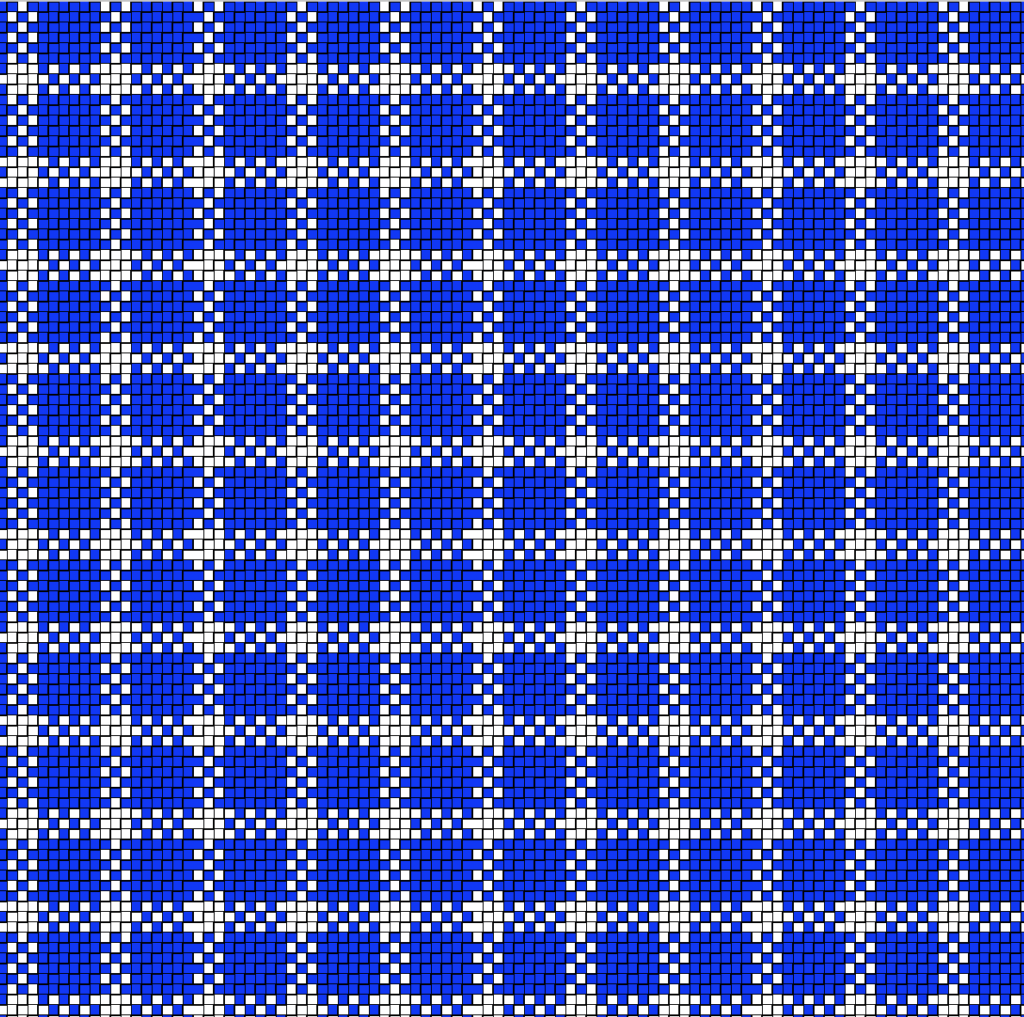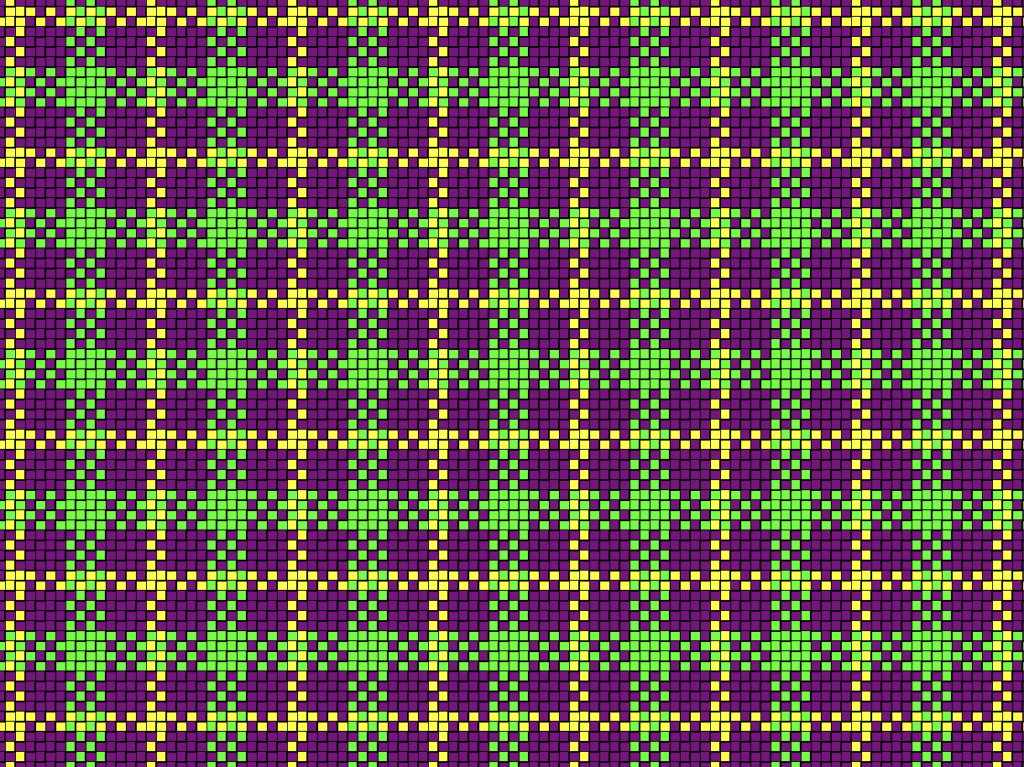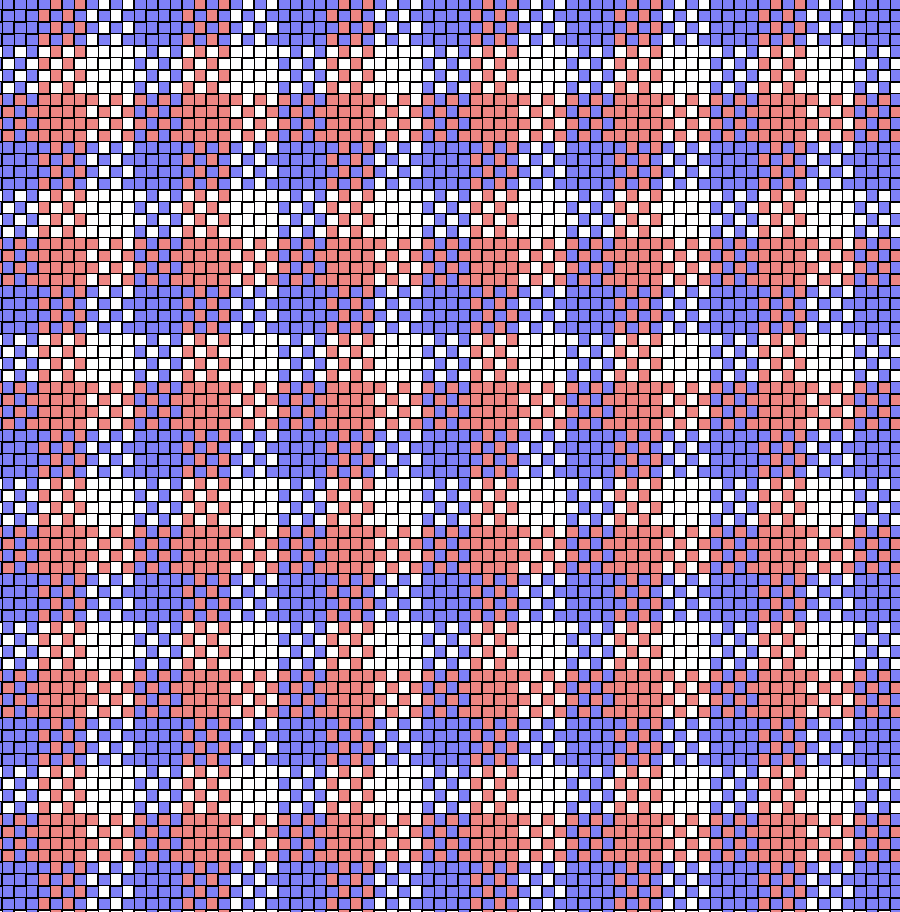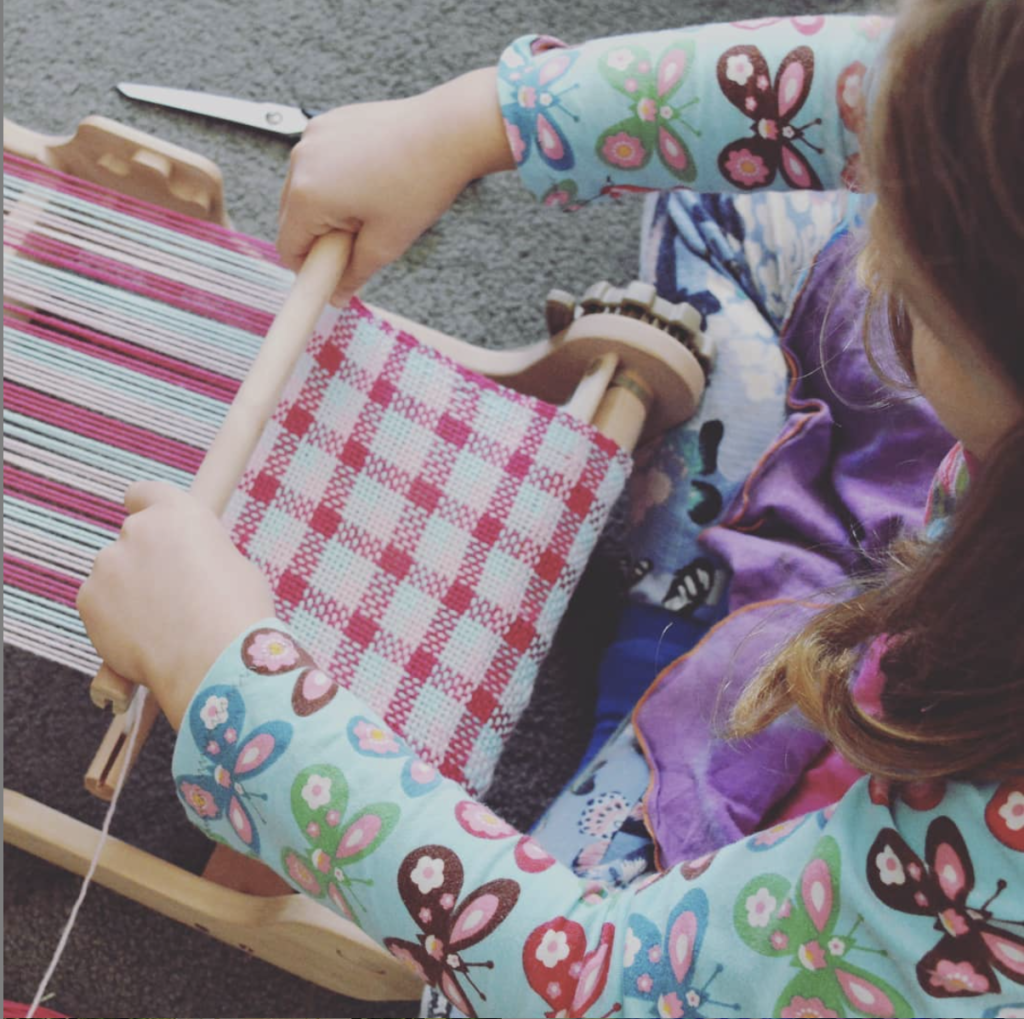Recently on the private member’s group on Facebook, we were discussing plaid and how it might look as a weaving draft. A very interesting topic!
So, first of all, what is plaid?
Quite simply, it is stripes of specific colours in the warp that are then repeated in the weft. A proper plaid will have the exact same treadling order as the warp, otherwise known as “tromp as writ” or “as drawn in” and is a balanced weave.
As the weft stripes cross the warp stripes, squares are formed.
There can be some heated discussions and disagreements about what makes a plaid and what makes a tartan. If you’re interested in researching tartan, this PDF is a detailed and interesting document.
For our member’s discussion, I made an example plaid draft based on a student’s desire to see what her colour ideas would look like. This is the fabric view of the draft.
It is a simple warp of 6 blue, 3 white repeated. The weaving sequence will also be 6 picks of blue, 3 picks of white.
*This post contains some affiliate links. This means that if you click on the link and buy, I receive a small commission at no extra cost to you.
Let’s have a look at what can happen if we vary colour arrangement and number.
This draft uses 3 colours instead of 2 and the warp colour repeats are 4 purple, 4 green and 2 yellow. I used a bold and modern colour scheme to illustrate how different a simple plaid draft can look. I quite like this one!
If you like this draft and want to try it out, I’ve made a printable PDF for your personal use.
Lastly, I made this very balanced draft in more muted colours. This draft uses 4 ends of each colour (purple, white, peach) and then repeats the same in the weaving.
You can grab a PDF of the draft for your personal use for the muted version too.
If you want to have a bit of fun making your own plaid designs, PlaidMaker is an excellent, free resource.
Regarding yarns that you might use to weave a plaid, there are so many choices! One of my personal favourites though (and I have one of my daughters to thank for this, as she designed and wove her own plaid piece) is a light worsted to worsted weight cotton with a 7.5 or 8 dent heddle.
Here are some possible cotton suggestions:
Bendigo Woollen Mills 8ply cotton
I strongly recommend that, whichever yarn you choose, go with a solid and not variegated colour. Plaids are “busy” to look at and using a variegated could change it from busy to messy!
I hope you learned a lot from this post. I would love to hear from you if it was helpful, and if you decide to use one of my drafts. Let me know by leaving a comment below!
Until next time…
Happy Weaving!






Hi Kelly,
Oh dear, yet again the words plaid and tartan have been confused. The plaid was a long piece of cloth carried to help keep out the cold, or as a blanket. It was kilted around the waist (wrapped around the waist and belted to hold it in place often with a length of rope, then the long end passed over the shoulder). The plaid was woven in patterns of stripes and squares, with yarns dyed according to the local facilities. The tartan, the kilt (the pleated skirt) were both ‘born’ in the early 1850s with Sir Walter Scott being responsible from his book, “Rob Roy”. Nowadays there are stylised, even new, tartans but they have little to do with the Highlanders of the 1745 Rebellion.
My heritage is mostly Scots, being descended from before the first millenium, so I am fairly familiar with the history.
I did actually read about the plaid worn as a garment but didn’t mention it here. Are you saying that the modern day “plaid” weave can’t be called plaid? Or can the word actually have two meanings – the garment and the weaving? This is what the dictionary says:
noun
chequered or tartan twilled cloth, typically made of wool.
“a plaid shawl”
a long piece of tartan worn over the shoulder as part of Scottish Highland dress.
plural noun: plaids
Another excellent article. And I’m enjoying working on my plaid that you helped me with.
I just saw it on Facebook, it’s looking fabulous!
For some time I have had plans to make cloth to make a top for myself. Two reds are a bit different and there is one that is a neutral (light beige) that will be obvious but not overwhelming the reds. The plan for the bright plaid will be perfect for my plan. It had been stewing in my thinking for too long and now I know what to do. Thanks!! Excitement returns!
That’s wonderful!
The timing of this post is perfect, as I have planned to make myself a Rob Roy plaid of red and black (so popular this year) of wool yarns, slightly felt it, and Create a new winter (its winter here in the US) cross-over bag. Thank you Kelly for this timely post!
I’ve noticed that I’m seeing a lot fo red and black plaids this year. Your plans sound great!
Hello Kelly,
Thanks for this post. I just reread it this morning. I am planning on doing a plaid Christmas runner. I have a question regarding one of the comments you made. You talked about tucking the cut ends into the selvedge could you explain a little more. When I change colors or add more yarn, I usually just weave the tail into the next pick, of course that makes a thicker line. Just curious if this is a different treatment for the ends.
Thanks,
Alan
Hi Alan,
Weaving in the tail and the tucking in that I describe are pretty much the same thing. I just make sure I don’t take the tail in any more than 4 warp threads, as I want to tail to sit in the tightest part of the warp, which is right at the selvedge.
Hi Kelly,
I just finished my first attempt at a three colour plaid and I’m just in the process of snipping all the ends from transitioning colours. I wet finished first but to be honest I’m not confident that the ends will stay put and not start to come untucked and show. Do you have some tips or resources on how to make those transitions? I wasn’t keen to carry the colours up the selvages as I’ve seen that turn out rather bulky. Maybe I’ll post a pic on your FB site. Thanks.
Marge, I’m guessing that you tucked to cut ends into the selvedges? In that case, they should stay put quite well. Carrying up the selvedges works fine if you have short repeats (say 1, 2 or 3 picks of each colour) but beyond that, as you said, it does get a bit bulky and can look unattractive.
How do you change
The colors in the weft? Do you cut the yarn each time of some how carry it forward on the sides?
Sharon, it depends on how many picks you are weaving of each colour. If you’re changing colours every 1, 2 or 3 picks its fine to carry the yarn up the sides, it can become a sort of design feature. But, beyond that it can get too bulky and start to look unattractive. I usually cut the ends when changing colour, tuck the tail into the selvedge and start the new colour. Try to alternate sides when doing this, to avoid a build up of cut ends on one side.
Thank you for explaining this! I’m going to try it. I’ve done large checks before, but not the balanced weave that you’ve laid out here. Do you think I could do a tartan plaid on my RH? My husband and I have gone to many, many Highland Games over the years and he has his own kilt. I’m allergic to wool, so mostly stay away from tartans even though I love them. Tried using my RH with 4 shafts for a project and it did not go well! lol But I sure love my 2 shaft RH.
Kay, if you want to do a proper tartan, it would have to be on 4 shafts as traditional tartan is twill. Have you seen this class? It may help you to understand using 4 shaft drafts on a RHL. http://kelly-casanova-weaving-lessons.teachable.com/p/converting-pattern-drafts-to-the-rigid-heddle-loom/?preview=logged_out
Another option would be to do a tartan “look” by arranging the colours in the way that you would for a traditional tartan, but weave it in plain weave instead?
How do you decide what color the weft should be? Or do change the weft as yo7 go along. Obviously I’m a new weaver.
Thanks for all you have taught me so far!
Hi Marilyn,
You use the exact same colours that you used for the warp and in the same order. So, if my warp was 4 green, 6 purple, my weft would start with 4 green, then change to 6 purple and repeat. Does that make sense?